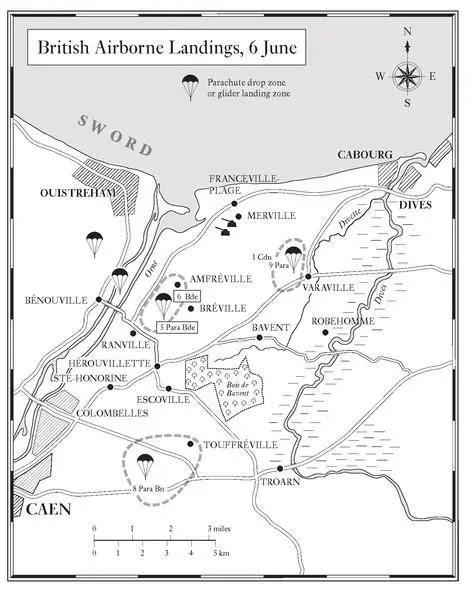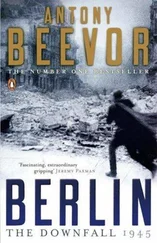During the hour before midnight on 5 June, the roar of hundreds of aircraft engines in a constant stream could be heard over villages near airfields in southern and central England. People in their nightclothes went out into their gardens to stare up at the seemingly endless air armada silhouetted against the scudding clouds. ‘This is it’ was their instinctive thought. The sight evoked powerful emotions, including painful memories of the evacuation from Dunkirk four summers before. Some went back inside to kneel by their beds to pray for those setting forth.
Three airborne divisions were taking to the air in over 1,200 aircraft. The British 6th Airborne Division was headed for the east of the River Orne to secure Montgomery’s left flank. The American 101st and 82nd Airborne Divisions would be dropped on the Cotentin peninsula to seize key points, especially the causeways across the flooded areas inland from Utah beach.
The first group to take off was D Company of the 2nd Battalion, Oxfordshire and Buckinghamshire Light Infantry. They left even before the pathfinder detachments sent ahead of the main force to mark dropping zones. This company, commanded by Major John Howard, was flown in six Horsa gliders towed by Halifax bombers. Officers and soldiers all had blackened faces and wore round paratroop helmets with camouflage netting. They were armed with a mixture of rifles, Sten sub-machine guns and several Bren guns. The Halifaxes took them over to the east of the invasion fleet and aimed for the seaside resort of Cabourg, where there was a gap in the German flak defences. The gliders were at an altitude of 5,000 feet when the tow lines were cast off. Howard told his men to stop their songs, which had been bellowed out for most of the way across the Channel. From then on there was no noise apart from the rushing wind. The pilots banked, turning the flimsy craft westwards. After losing height rapidly, they flattened out at 1,000 feet for the approach.
Their objectives were two bridges close together, one over the River Orne and the other over the Caen Canal. They had to seize them before the Germans guarding them could blow demolition charges. Howard, who had positioned himself opposite the door on the first glider, could see the gleam of the two parallel waterways below. As his Horsa swept in, the men braced themselves for the shock of landing. The two pilots brought the cumbersome glider in with astonishing accuracy. After bumping and leaping and skidding across the field, the nose of the glider came to a halt penetrating the barbed-wire entanglement. The two pilots were knocked unconscious in the crash, but they had achieved a landing within fifty feet of the pillbox beside the bridge.
Some of the plywood Horsa gliders — unaffectionately known as ‘Hearses’ — broke up on impact, so soldiers scrambled out through the broken sides as well as the door. Within moments, the first men out of Howard’s glider had hurled grenades through the slits of the pillbox on the west side of the Caen Canal. The rest of the platoon did not wait. Led by Lieutenant Den Brotheridge, they were already charging across the bridge. Howard had made sure they were at the peak of fitness with cross-country runs. But by the time Brotheridge’s platoon reached the other side, the German guards had got themselves together and opened fire. Brotheridge was mortally wounded from a shot through the neck and died soon afterwards.
Another platoon arrived led by Lieutenant Sandy Smith, although he had broken his arm badly in the landing. After a fierce but mercifully brief firefight, the bridge over the Caen Canal was secured. Howard was concerned at having heard nothing from the platoon ordered to take the bridge over the Orne, a few hundred yards beyond, but then a message arrived to say that they had secured it without the defenders firing a shot. Its commander, Lieutenant Dennis Fox, took a certain pleasure in greeting the next platoon to arrive, panting heavily since they had landed half a mile off target. When asked how things stood, he replied, ‘Well, so far the exercise is going fine, but I can’t find any bloody umpires.’

Howard immediately ordered an all-round defence and sent Fox’s platoon out in fighting patrols to probe the nearby village of Bénouville. The curious choice of success signal for the two bridges — ‘Ham and Jam’ — was sent off by radio. Howard could hardly dare believe that such a tricky operation had gone entirely according to plan, but then at 01.30 hours the platoons defending the bridges heard the unmistakable noise of armoured vehicles beyond Bénouville.
By then paratroopers were landing all over the place. German officers in command posts along the Normandy coastline were desperately ringing regimental headquarters on field telephones. In some cases they could not get through because the Resistance had cut the lines and they had to resort to their radios. To increase confusion, the RAF had mounted Operation Titanic, with a force of forty Hudsons, Halifaxes and Stirlings. They dropped dummy parachutists and ‘window’ aluminium strips to confuse the radar, as well as SAS teams to simulate airborne landings away from the invasion area. The SAS teams were there to cause mayhem behind the lines and give substance to the dummy parachutists. Some 200 dummies were dropped south of Carentan at the base of the Cotentin peninsula, fifty more east of the River Dives and fifty to the south-west of Caen. They were little more than rough scarecrows, with a device to make them explode and catch fire on landing. The Germans called them ‘ Explosivpuppen ’. Soon after 01.30 hours, teleprinters began chattering in corps and army headquarters, but reports of these ‘exploding puppets’ caused most commanders to think that all the attacks were simply part of a large-scale diversion, probably for the main landing in the Pas-de-Calais. Only Generalmajor Max Pemsel, the chief of staff of the Seventh Army, recognized at the time that this was the major invasion, but Generalleutnant Speidel at La Roche-Guyon refused to believe him.
Generalleutnant Joseph Reichert, who commanded the 711th Infanterie-Division to the east of the Orne estuary, had remained talking in the officers’ mess until late. On the point of going to bed, he and his companions heard aircraft engines overhead. ‘The planes were flying so low that we had the feeling they might almost touch the roof,’ he wrote later. Reichert and his companions went outside to have a look. ‘It was a night of the full moon. The weather was fairly stormy, with low-hanging black clouds, but in the gaps between them several low-flying planes could be distinctly observed, circling the divisional command post.’ Reichert went back inside to grab his pistol, then heard the shout of ‘Parachutists!’ Paratroopers were coming down all round his divisional headquarters. The 20 mm quadruple flak guns on the main strongpoint opened fire.
While his operations officer alerted the division, Reichert rang LXXXI Corps headquarters at Rouen. By this time the guns had stopped firing, leaving an uneasy calm. Reichert, who had been sceptical about the whole invasion, now sensed that it really was starting, even if this attack was only a feint. Two captured British paratroopers were brought in, but they refused to answer questions. The accuracy of the maps found on them shook Reichert. They showed almost every gun emplacement. He deduced that the French Resistance had been even busier than the Germans had imagined. Not all prisoners were so fortunate. Elsewhere in the sector, a Hauptfeldwebel in Reichert’s division executed eight captured British paratroopers, probably in obedience to Hitler’s notorious Kommandobefehl , which demanded the shooting of all special forces taken on raids.
Читать дальше












